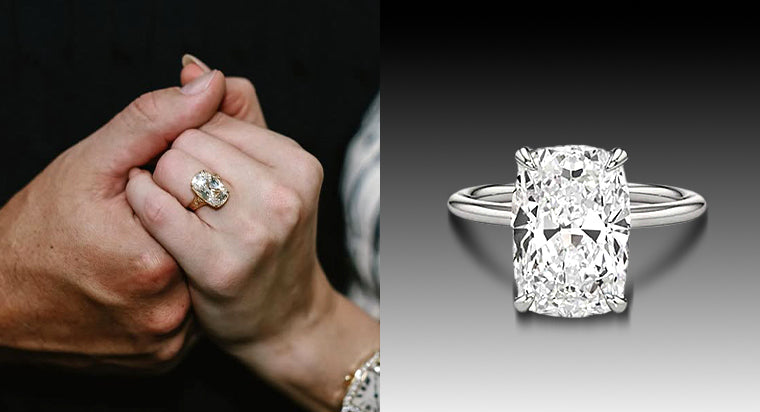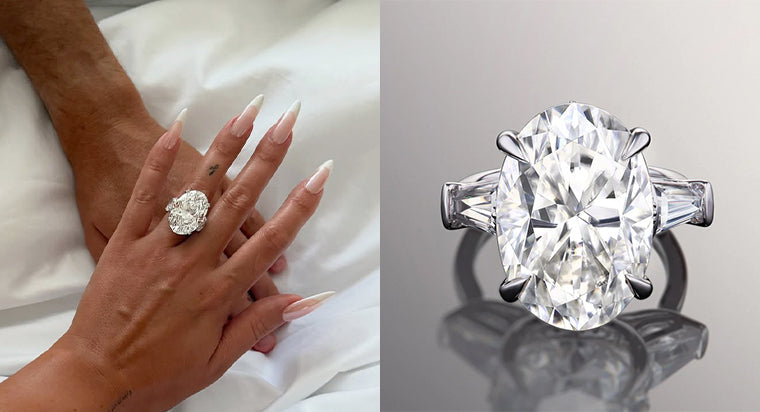Your Definitive Handbook to Lab Grown Pavé Engagement Rings

Lab grown pavé diamond engagement rings are all the rage, and there are plenty of reasons. They're an ethical, sustainable option for consumers, and you'll also save some money. Lab diamonds and natural diamonds look identical physically, chemically, and optically. No one can tell the difference; you can have peace of mind with your diamond choice.
TABLE OF CONTENTS
Introduction to Lab Grown Diamonds
Lab diamonds were first made in 1954, but the technological advances since then have perfected the lab grown diamonds you'll see today. Labs recreate the high temperature and intense pressure needed to transform carbon into stunning diamonds. Lab diamonds come with some added benefits, too. They're ethically sourced, so you can be content knowing your stone isn't a conflict diamond. They're a sustainable option because they're made in a laboratory rather than mined from the earth.
Understanding Pavé Settings
You've probably seen pavé settings but might not be familiar with the term. The word 'pavé' is the French word for pavement, and the tiny diamonds individually set closely together look like diamond-covered pavement. Pavé bands are common in engagement rings because they add sparkle without removing the focus on the center stone.
Benefits of Lab Grown Diamonds in Pavé Settings
Lab grown diamonds work well in pavé settings because it's easy to get diamonds that are uniform in size, clarity, and color. You want all the diamonds in the setting to look alike for the aesthetic appeal of the ring. Lab made diamonds is more affordable, which will make your engagement ring more affordable as well. You don't have to stretch your budget to get the ring of your dreams.
Quality Considerations
Like natural diamonds, the 4Cs are used to evaluate the quality of lab diamonds (color, clarity, carat, and cut). Each of these elements plays a role in the beauty of the diamonds, and they're important to consider for your ring - especially for the center stone. Educating yourself about diamond quality will help you feel more comfortable when shopping for rings and allow you to ensure you're making a smart purchase.
Design Options
Pavé settings are appealing because this detail is flattering in many different settings. You'll see designs ranging from modern to vintage and everything in between. Check out this vintage pavé knife edge engagement ring where the diamond band has a vintage touch. This French cut pavé engagement ring has a modern feel. Once you find a setting you like, you can easily customize the ring to fit your preferences by choosing the metal, the band width, and the perfect center stone.
Budget Friendly Alternatives
Lab grown diamonds are typically around 40% cheaper than natural diamonds. This is because they're made in a lab instead of the more complicated supply chain for mined diamonds. Choosing lab made pavé engagement rings offer luxury and beauty at an affordable price. You'll see settings in all different price points, from this under halo engagement ring to this pave halo and shank engagement ring.
Ethical and Environmental Considerations
Lab diamonds get created in a lab rather than mined in another country, so you'll be able to know exactly where your diamond was made. Knowing this provides peace of mind that you're purchasing an ethical diamond. You'll also have peace of mind purchasing a sustainable diamond. Lab diamonds have a reduced carbon footprint compared to mined diamonds.
Maintenance and Care
Lab grown diamonds are built to last, and you can keep them that way by caring for and maintaining them. In terms of care, ensure you don't wear your engagement ring when working with your hands, exercising, swimming, or cleaning. Protect your ring from loss or damage by keeping it at home when needed. In terms of maintenance, periodically take your ring in for a professional checkup with a jeweler. They'll examine your ring under a microscope to ensure none of the diamonds are loose and that all the prongs hold your center stone and pavé diamonds in place. It's also good to clean your ring at home to remove grime that gets stuck in the setting and can dull your diamond.
Consumer Confidence
Educating yourself about different categories of settings and diamond quality can help you make an informed decision. See what style of pave setting you're drawn to and look at similar designs to research the price variations. There are plenty of misconceptions about lab diamonds. A common myth is that they're not "real" diamonds, but that isn't the case. Lab grown diamonds and natural diamonds have the same physical, optical, and chemical characteristics. They're both a 10 on the Mohs hardness scale, meaning they're the hardest material on earth. Both lab and mined diamonds are durable, strong, and will last a lifetime. Look for certified lab diamonds - a third party evaluates the diamond, so you receive a detailed report about your diamonds. It provides information about the quality of your lab diamond and proves that you're getting the diamond you purchased.
Conclusion
Pavé diamonds are versatile and can be used in all sorts of settings, from traditional to vintage to modern. Tiny diamonds are individually set in the band to give the engagement ring subtle sparkle and glamor. Lab diamonds make engagement rings more affordable and are also an ethical and sustainable choice. Maintaining and carefully caring for your lab diamonds will make your ring last a lifetime and ensure your diamonds are safe. With Clarity provides plenty of educational information about pavé diamonds if you want to research more before purchasing your dream lab grown diamond engagement ring.









